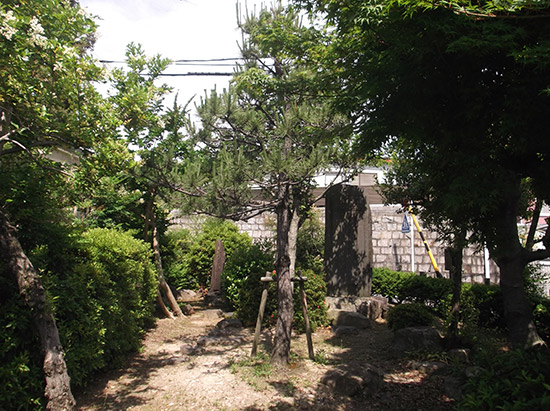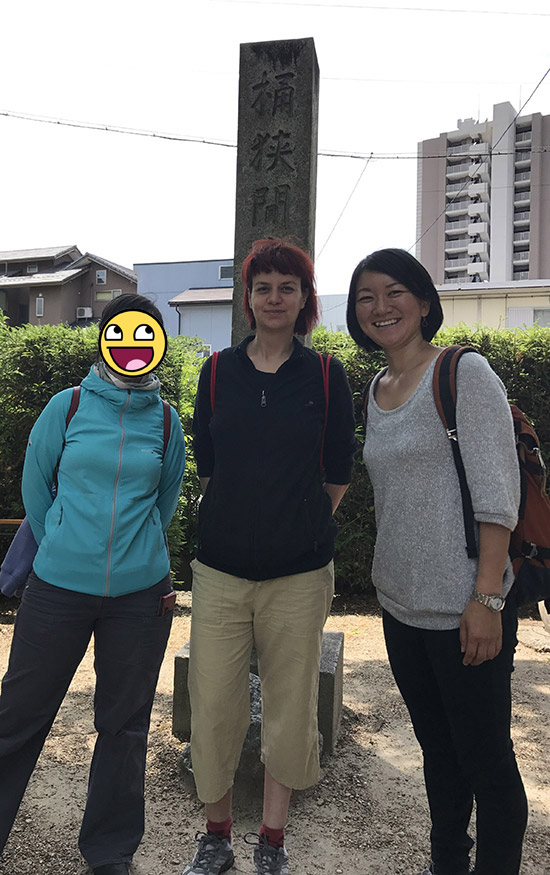ODA NOBUNAGA TOUR/ Arimatsu vs Toyoake + Konan
So, the day after the stamp rally marathon was the day that me and Teap dedicated to passionate touristic walking.
We checked out again the Okehazama Battlefield because I wanted to attend the first day of the Okehazama Historical Battlefield Festival of Toyoake.

So, in the morning we met with Mayuko, one of the guides of Tourism Designers, and we proceeded to an overview of the battlefield of Arimatsu, the one located in Nagoya city, and the one we visited already five years ago (!!).
During our tour we tried to retrace the steps of Yoshimoto Imagawa's army, so we first reached the hypotetical spot of Okehazama mountain, the place were Yoshimoto was resting his troops after the invasion of Owari.


From there we got back to the park, the place where, according to Arimatsu's people, Nobunaga defeated the huge army of Yoshimoto with his fewer soldiers.


We took our time to investigate the various landmarks around.
Mayuko pointed out this tomb, that apparently is the one where Yoshimoto was buried (it's the one on the left).

They noticed that the engravings on it, "駿公墓碣", "The tomb of the lord of Suruga/Sunpu", may refer to Yoshimoto and the famous battle of Okehazama and drew their conclusions.
They identified this now dead juniper as the tree were Yoshimoto tied his horse.

On our way to the Okehazama temple, we were showed this pine, that apparently marked the location were Sena Ujitoshi, "a general in the Imagawa army, rallied his lieutenants to discuss strategy".

So we reached the Okehazama Temple (桶狭間神明社, Okehazama Shinmeija) where Sena went to pray for the protection of the Gods during the crossing of Owari province.


It's quite the interesting example of typical shinto temple, and it looked like it still preserved the sake presented by Sena at the time as a donation.
On our way to the Toyoake spot, we stopped at Choufukuji (長福寺).
This is the temple were Nobunaga stopped to check out the heads of Yoshimoto and his generals, the trophies of his army.



In the temple precints there is also this interesting, cute little pond:

On the hill where Kotoku'in is placed, one could spot a few more interesting spots:



It was kinda amusing how all the spots related to Yoshimoto were bad news! That's the destiny of the loser, my friends!
So, we finally took our time to take a look around the Toyoake battlefield. But why there are two battlefields, and two different locations for Yoshimoto's grave?!

The walk was organized so that we could savour the bits of the matsuri, that on the first day was limited to a series of memorial ceremonies dedicated to the fallen soldiers of both parts and Yoshimoto.
As we reached the historical park of Toyoake, buddhist monks were chanting sutra for the "Greatest Warrior of Tokai":


Anyway, we profitted of the busy mood of the area, animated by the presence of the volunteer guides to check the spots around... This is when one of the volunteers reached for us and started to translate the Okehazama Chokohi (桶狭弔古碑) for us! It's been awesome, and extremely informative!
This is how we got a better overview of the battle and we got more insight about the "quarrel" between Nagoya and Toyoake about the location of Yoshimoto's tomb!

He lamented that "the ancient battlefield fell into ruin", so he gave his contribution to this historical site where anyone could read the "official" chronicle of the Okehazama battle.
Given what's written on the Chronicle of Lord Nobunaga this reconstruction made perfect sense:

"Having observed Nobunaga arrive at the Zenshoji, the two captains Sassa Masatsugu and Senshu Suetada advanced toward Yoshimoto's light infantry with their troop of roughly three hundred. But the enemy countered their attack massively. Senshu Suetada, Sassa Masatsugu, and about fifty other men-at-arms were killed in the thick of battle".
This is what happens in the first picture above, and the location is the battlefield of Arimatsu, in Nagoya.
"At the hour of the Sheep, he [Nobunaga] attacked toward the east. Imagawa men-at-arms formed a circle around Yoshimoto, covering him while they retreated. Twice, Thrice, four and even five times they counterattacked, but their numbers were gradually depleted. [...]
Nobunaga, too, dismounted and competed with his young samurai to be the first at the enemy, pulling down and pushing down people. The youngsters impantiently plunged into the melee. [...]
Hattori Kazutada took on Yoshimoto but was slashed across the kneecap and fell prostrate. Then Mori Yoshikatsu struck down Yoshimoto and cut off his head."
And this is what happens on the second picture, the location being the battlefield of Toyoake city.
The struggle between the two sites, about which one is the real spot of Yoshimoto's death, apparently was resolved on 1938, when the Ministry of Education gave the official title of "Okehazama Battlefield" to Toyoake city, but Nagoya is not giving up yet!

The debate between Arimatsu and Toyoake made me think about the whole deal.
Personally, I tend to recognize the version of Toyoake, given that its monuments, the landmarks for the burial mounds of Yoshimoto's seven vassals, were more ancient (placed there on 1771 by the locals), but it must be noted that the tomb of Yoshimoto in the park was placed there on 1876, because people kept mistaking the Chokohi for Yoshimoto's tomb... The buddhist tomb placed on Kotoku'in slope dates 1860.
Yet, the tombstone of Arimatsu was discovered on 1933, even if it's not possible to know how old is it.

Yet, the charm of these places is undeniable, and the hope that research could give us a proper answer is always there.
It was just 11 in the morning but I was extremely hungry, so I dragged everyone to lunch, lol.
Mayuko brought us to a nice kaiten sushi place with lots of delicious stuff!

So, we left Mayuko at Nagoya station and headed for the next part of our tour, this time dedicated to Kitsuno and the Ikoma clan.
Kitsuno is regarded as Nobunaga's most beloved concubine, and in some TV drama she's even listed as the "real" wife of Nobunaga, but in recent years her figure got quite downsized.
For example, it was revealed that Nobunaga's fixation for Kitsuno was mostly related to the power of the Ikoma clan that controlled the area of Konan, a bountiful location that intrigued Nobunaga both economically as strategically.
There is also a talk about the fact that Nobutada, the heir of Nobunaga and head of the clan after him, wasn't the son of Kitsuno, but he was related to some woman of Mino who probably accompanied Kichou in her transfer to Kiyosu... Yet, she's still a beloved character surrounded by legend, and it's interesting to dedicate a walk to her memory.

I was really surprised to see how extremely rural this area was.
Teap told me that she noticed too, during her trips, how locations that were once famous for being productive and rich are now nothing but fields and vegetable gardens.
She affirmed that probably it depended by the fact that once "prosperity" meant "rice", and rich terrains were kept in high esteem just because of this.
Sure is, if Konan is still so productive and rich of vegetable and goods, I'm sure it was quite the fief back in the old days!
So, our first stop of our placid walk was the spot were once stood the Ikoma Mansion (生駒屋敷跡):


Our second stop was Kyushoji (久昌寺), the family temple of the Ikoma family where Kitsuno was buried.


We were actually too tired to go "tomb hunting" there, so be happy with this random picture I took about some random Ikoma guy--!
Yet, this is a calm, nice place. I can figure Kitsuno resting in peace here along her brothers.
The last Kitsuno-spot of our walk is located in a tiny cemetery in the middle of nowhere, protected by a huge cherry tree.

Under here are buried part of her cremated remains; the statue faces the direction of Komakiyama Castle, the place where she died...
It was a fun, interesting walk, and I really appreciated the serene mood of this place.
If it looked a bit as it was in the old days, I could see Nobunaga leaving the intrigues of Nagoya behind his bck while rushing here on horseback to rest his mind at the Ikoma's..!
On our way back to Nagoya me and Teap digested our emotions through the cocktails of a Gundam Bar-- But that's probably another story--!
Daeva.